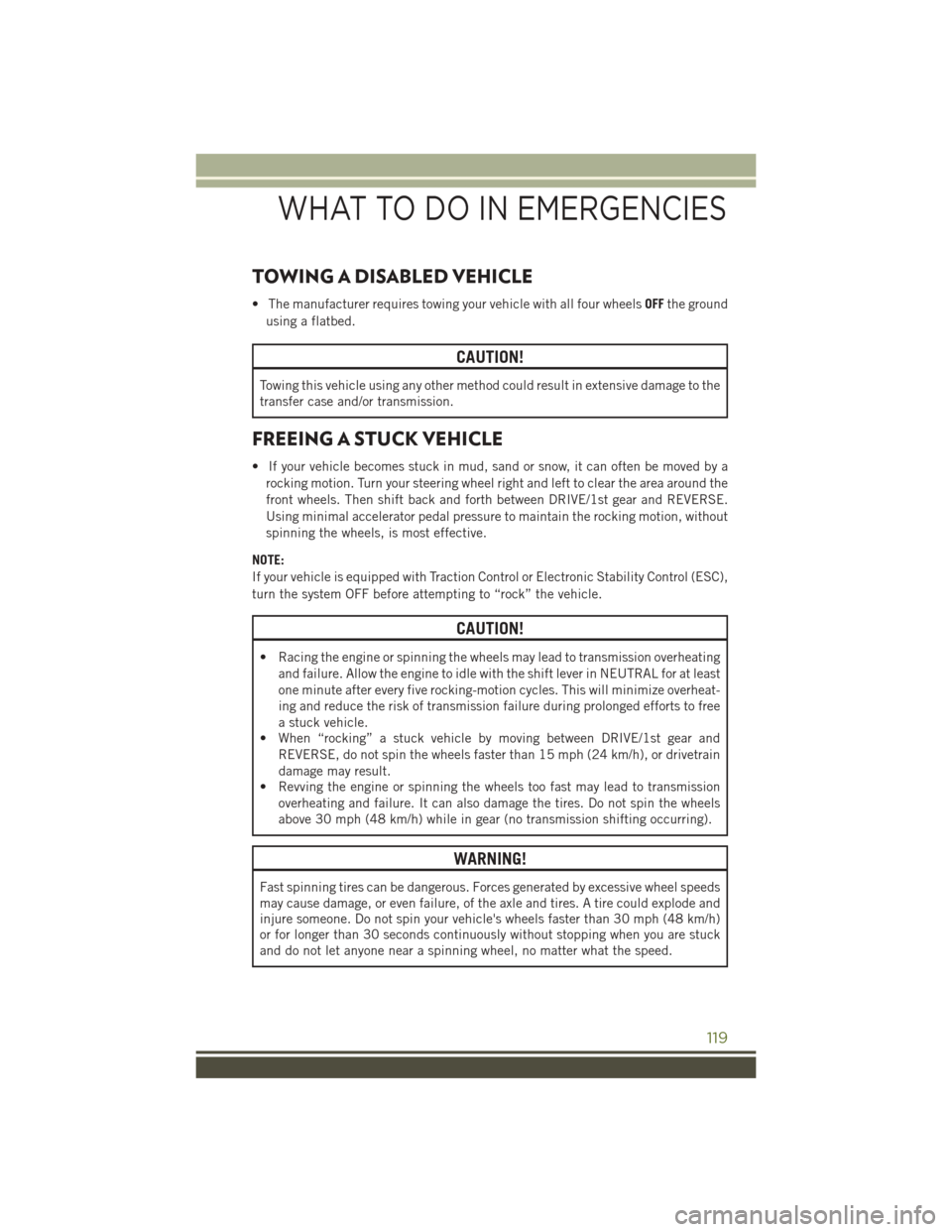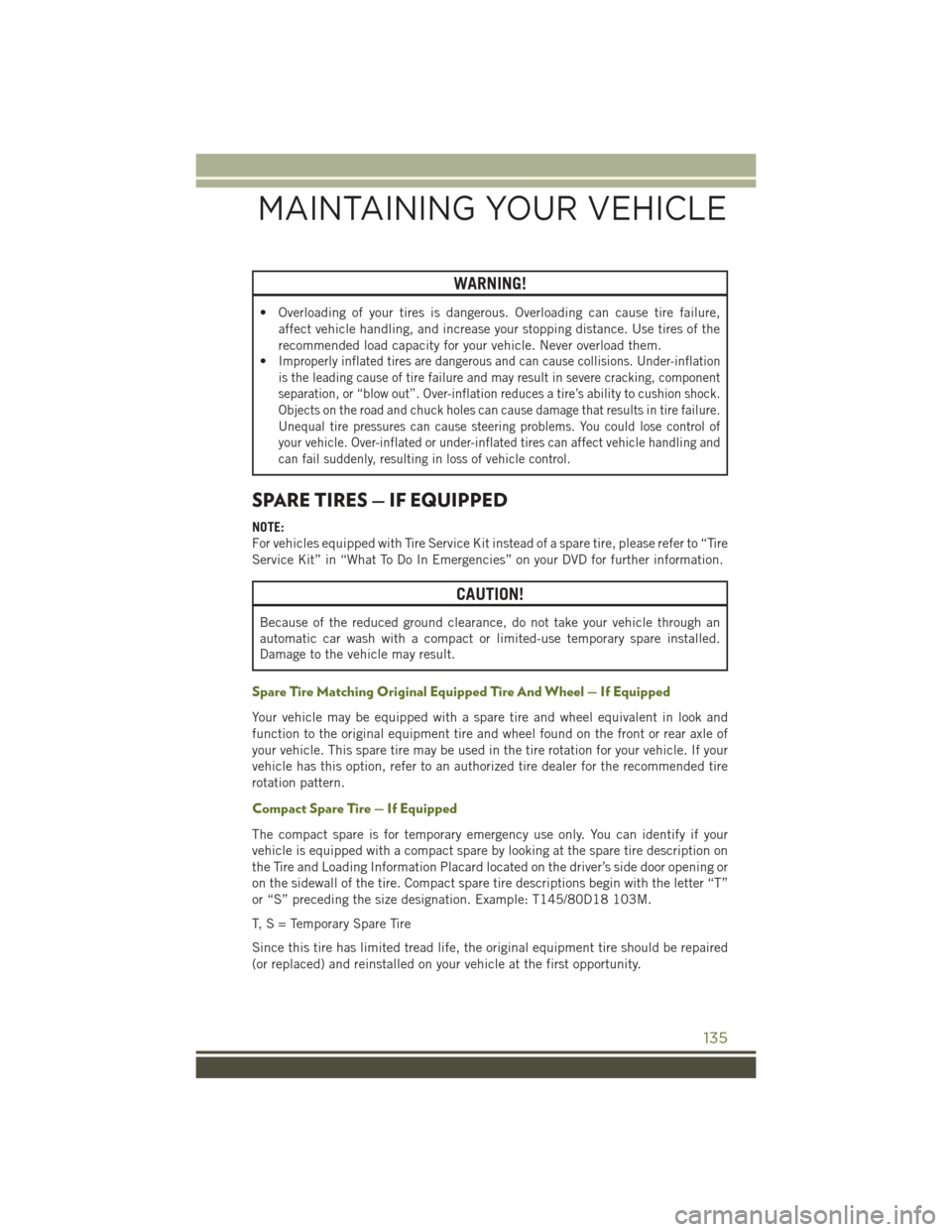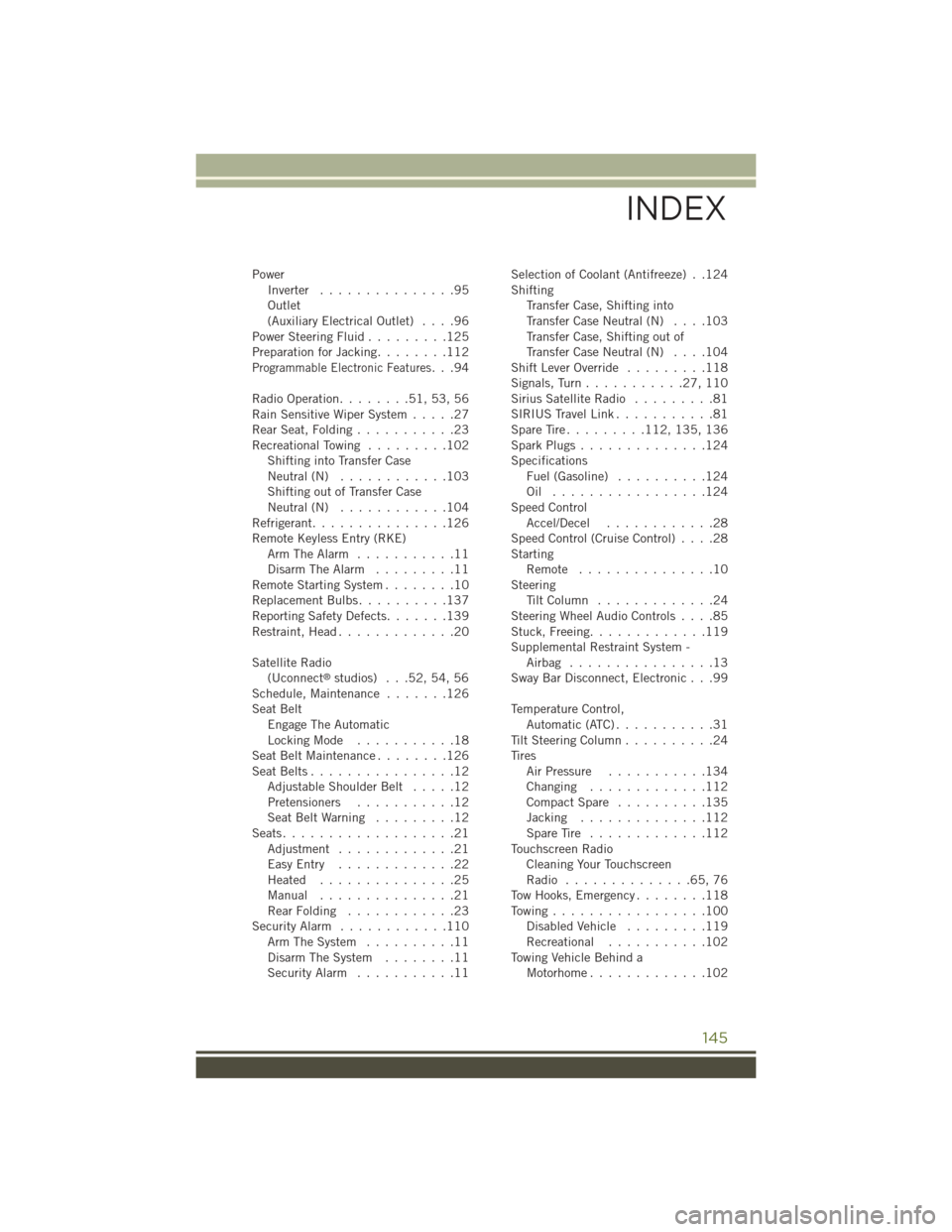steering wheel JEEP WRANGLER 2015 JK / 3.G Owner's Manual
[x] Cancel search | Manufacturer: JEEP, Model Year: 2015, Model line: WRANGLER, Model: JEEP WRANGLER 2015 JK / 3.GPages: 156, PDF Size: 23.54 MB
Page 121 of 156

TOWING A DISABLED VEHICLE
• The manufacturer requires towing your vehicle with all four wheelsOFFthe ground
using a flatbed.
CAUTION!
Towing this vehicle using any other method could result in extensive damage to the
transfer case and/or transmission.
FREEING A STUCK VEHICLE
• If your vehicle becomes stuck in mud, sand or snow, it can often be moved by a
rocking motion. Turn your steering wheel right and left to clear the area around the
front wheels. Then shift back and forth between DRIVE/1st gear and REVERSE.
Using minimal accelerator pedal pressure to maintain the rocking motion, without
spinning the wheels, is most effective.
NOTE:
If your vehicle is equipped with Traction Control or Electronic Stability Control (ESC),
turn the system OFF before attempting to “rock” the vehicle.
CAUTION!
• Racing the engine or spinning the wheels may lead to transmission overheating
and failure. Allow the engine to idle with the shift lever in NEUTRAL for at least
one minute after every five rocking-motion cycles. This will minimize overheat-
ing and reduce the risk of transmission failure during prolonged efforts to free
a stuck vehicle.
• When “rocking” a stuck vehicle by moving between DRIVE/1st gear and
REVERSE, do not spin the wheels faster than 15 mph (24 km/h), or drivetrain
damage may result.
• Revving the engine or spinning the wheels too fast may lead to transmission
overheating and failure. It can also damage the tires. Do not spin the wheels
above 30 mph (48 km/h) while in gear (no transmission shifting occurring).
WARNING!
Fast spinning tires can be dangerous. Forces generated by excessive wheel speeds
may cause damage, or even failure, of the axle and tires. A tire could explode and
injure someone. Do not spin your vehicle's wheels faster than 30 mph (48 km/h)
or for longer than 30 seconds continuously without stopping when you are stuck
and do not let anyone near a spinning wheel, no matter what the speed.
WHAT TO DO IN EMERGENCIES
119
Page 137 of 156

WARNING!
• Overloading of your tires is dangerous. Overloading can cause tire failure,
affect vehicle handling, and increase your stopping distance. Use tires of the
recommended load capacity for your vehicle. Never overload them.
•Improperly inflated tires are dangerous and can cause collisions. Under-inflation
is the leading cause of tire failure and may result in severe cracking, component
separation, or “blow out”. Over-inflation reduces a tire’s ability to cushion shock.
Objects on the road and chuck holes can cause damage that results in tire failure.
Unequal tire pressures can cause steering problems. You could lose control of
your vehicle. Over-inflated or under-inflated tires can affect vehicle handling and
can fail suddenly, resulting in loss of vehicle control.
SPARE TIRES — IF EQUIPPED
NOTE:
For vehicles equipped with Tire Service Kit instead of a spare tire, please refer to “Tire
Service Kit” in “What To Do In Emergencies” on your DVD for further information.
CAUTION!
Because of the reduced ground clearance, do not take your vehicle through an
automatic car wash with a compact or limited-use temporary spare installed.
Damage to the vehicle may result.
Spare Tire Matching Original Equipped Tire And Wheel — If Equipped
Your vehicle may be equipped with a spare tire and wheel equivalent in look and
function to the original equipment tire and wheel found on the front or rear axle of
your vehicle. This spare tire may be used in the tire rotation for your vehicle. If your
vehicle has this option, refer to an authorized tire dealer for the recommended tire
rotation pattern.
Compact Spare Tire — If Equipped
The compact spare is for temporary emergency use only. You can identify if your
vehicle is equipped with a compact spare by looking at the spare tire description on
the Tire and Loading Information Placard located on the driver’s side door opening or
on the sidewall of the tire. Compact spare tire descriptions begin with the letter “T”
or “S” preceding the size designation. Example: T145/80D18 103M.
T, S = Temporary Spare Tire
Since this tire has limited tread life, the original equipment tire should be repaired
(or replaced) and reinstalled on your vehicle at the first opportunity.
MAINTAINING YOUR VEHICLE
135
Page 147 of 156

PowerInverter...............95Outlet(Auxiliary Electrical Outlet)....96Power Steering Fluid.........125Preparation for Jacking........112Programmable Electronic Features...94
Radio Operation........51,53,56Rain Sensitive Wiper System.....27Rear Seat, Folding...........23Recreational Towing.........102Shifting into Transfer CaseNeutral (N)............103Shifting out of Transfer CaseNeutral (N)............104Refrigerant...............126Remote Keyless Entry (RKE)Arm The Alarm...........11Disarm The Alarm.........11Remote Starting System........10Replacement Bulbs..........137Reporting Safety Defects.......139Restraint, Head.............20
Satellite Radio(Uconnect®studios) . . .52, 54, 56Schedule, Maintenance.......126Seat BeltEngage The AutomaticLocking Mode . . . . . . . . . . .18Seat Belt Maintenance . . . . . . . .126Seat Belts................12Adjustable Shoulder Belt.....12Pretensioners...........12Seat Belt Warning . . . . . . . . .12Seats . . . . . . . . . . . . . . . . . . .21Adjustment . . . . . . . . . . . . .21Easy Entry . . . . . . . . . . . . .22Heated...............25Manual...............21Rear Folding . . . . . . . . . . . .23Security Alarm............110Arm The System..........11Disarm The System........11Security Alarm...........11
Selection of Coolant (Antifreeze) . .124ShiftingTransfer Case, Shifting intoTransfer Case Neutral (N)....103Transfer Case, Shifting out ofTransfer Case Neutral (N)....104Shift Lever Override.........118Signals, Turn...........27,110Sirius Satellite Radio.........81SIRIUS Travel Link...........81Spare Tire . . . . . . . . .112, 135, 136Spark Plugs . . . . . . . . . . . . . .124SpecificationsFuel (Gasoline)..........124Oil . . . . . . . . . . . . . . . . .124Speed ControlAccel/Decel............28Speed Control (Cruise Control)....28StartingRemote . . . . . . . . . . . . . . .10SteeringTi l t C o l u m n . . . . . . . . . . . . . 2 4Steering Wheel Audio Controls....85Stuck, Freeing.............119Supplemental Restraint System -Airbag . . . . . . . . . . . . . . . .13Sway Bar Disconnect, Electronic . . .99
Temperature Control,Automatic (ATC)...........31Tilt Steering Column..........24TiresAir Pressure...........134Changing . . . . . . . . . . . . .112Compact Spare..........135Jacking..............112Spare Tire . . . . . . . . . . . . .112Touchscreen RadioCleaning Your TouchscreenRadio . . . . . . . . . . . . . .65, 76Tow Hooks, Emergency........118To w i n g . . . . . . . . . . . . . . . . . 1 0 0Disabled Vehicle.........119Recreational...........102To w i n g V e h i c l e B e h i n d aMotorhome.............102
INDEX
145